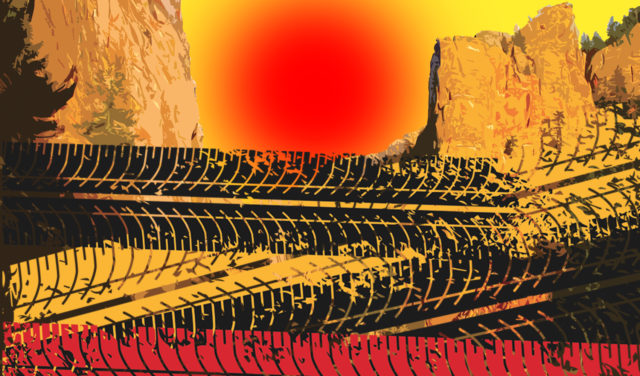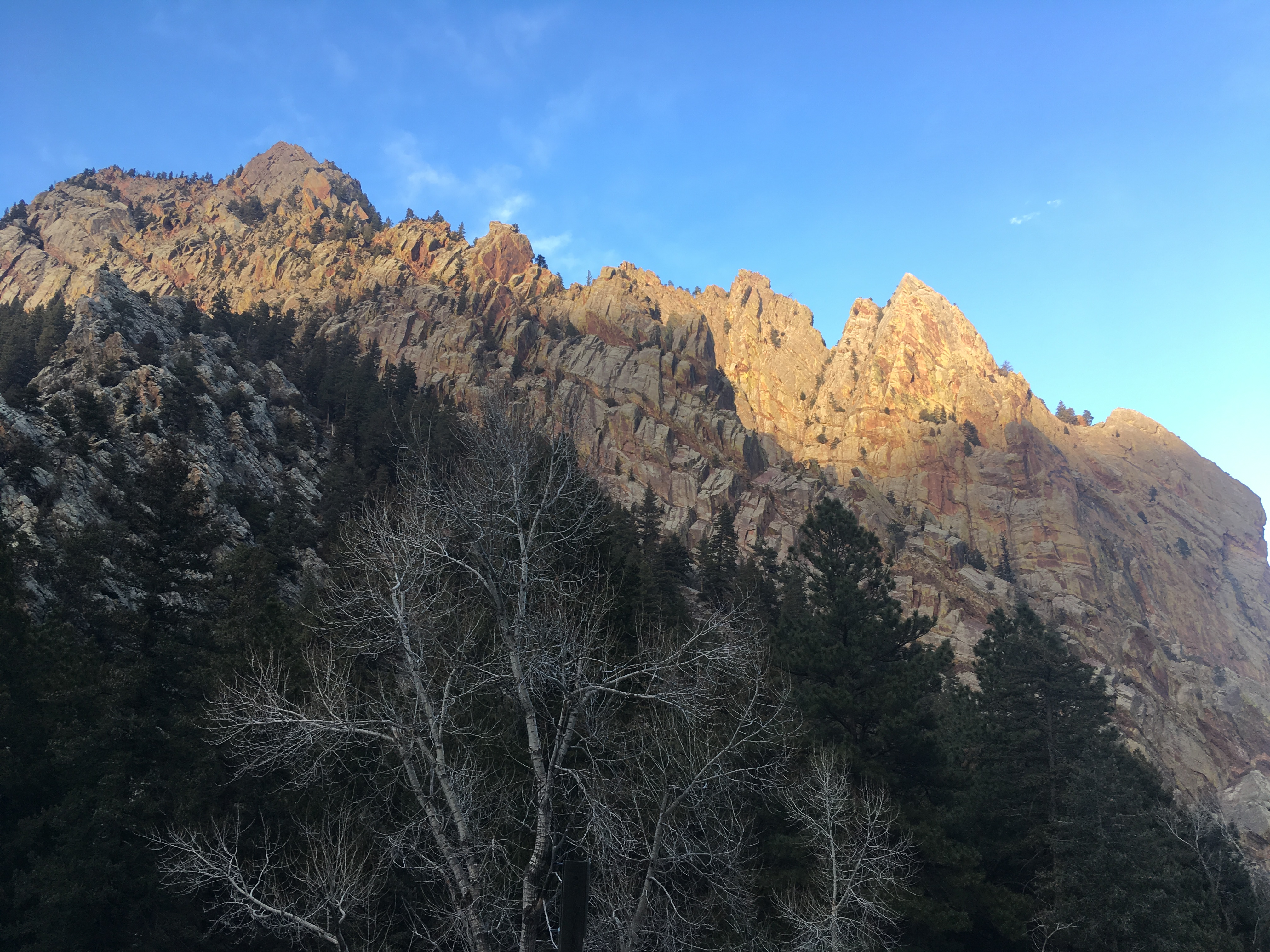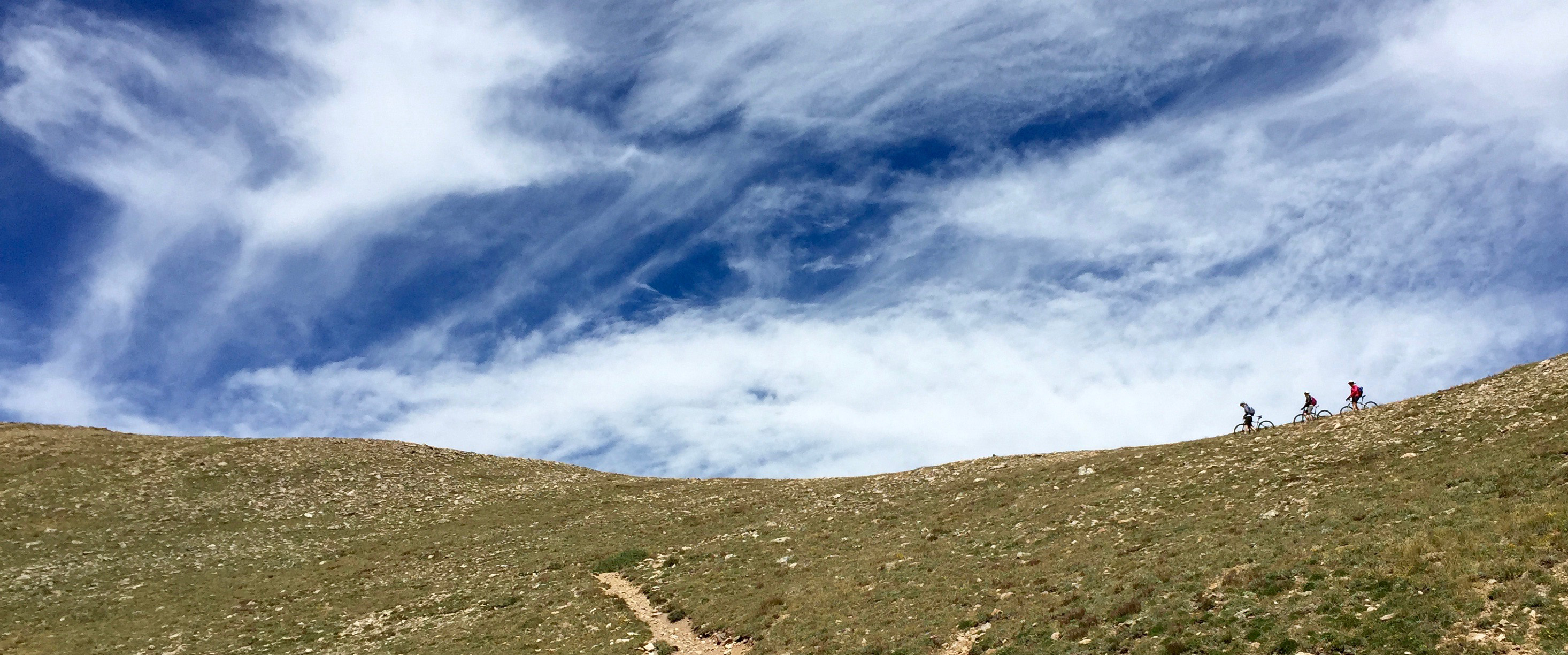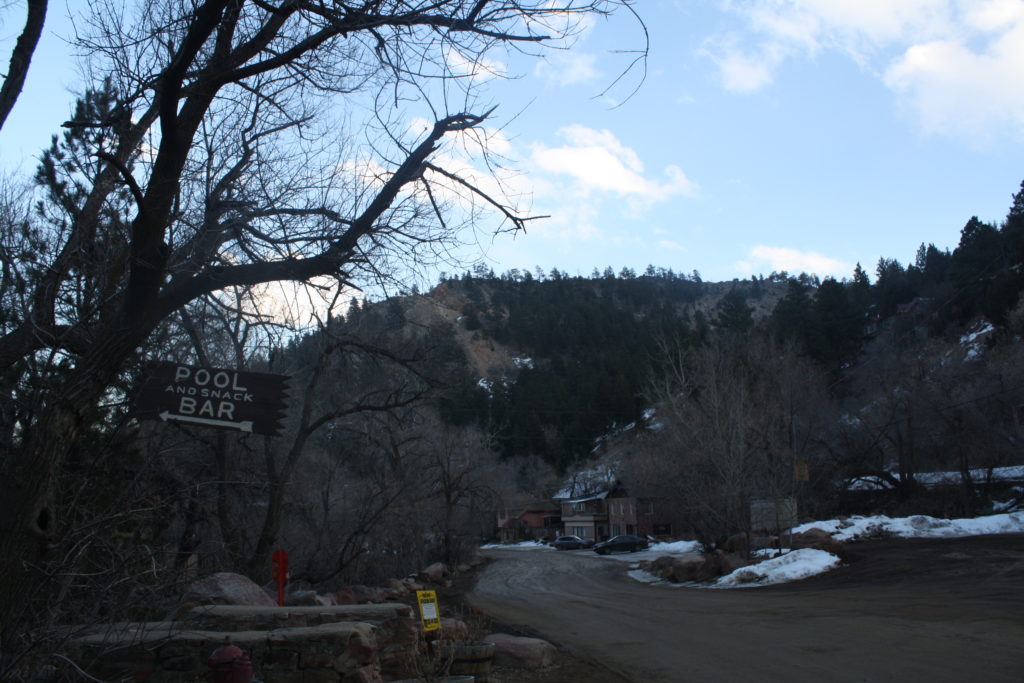
Turn west off Highway 93 onto Highway 170 and follow the pavement until the speed limit drops from 45 to 35, 25 to 10 mph. Right around there is where the road turns to dirt, and potholes appear soon after.
Ten mph seems about right — you don’t want to fly by the town of Eldorado Springs and the walnut trees Vira Ann Barber planted after arriving from Pennsylvania in 1860, or the ponderosa pines under which Dwight and Mamie Eisenhower might’ve lounged during their honeymoon in 1916, or the eclectic collection of homes that line the dirt road like old friends watching a summer-day parade.
Wind your way past the potholes, past the Eldorado Springs pool, an area where indigenous tribes like the Ute, Cheyenne and Arapaho used to frequent for health and spiritual renewal, and past the Eldorado Canyon State Park entrance station. Here you enter a 1.6-billion-year “panorama of geologic history,” as Colorado Parks and Wildlife (CPW) describes the canyon’s steep sandstone cliffs, granite flakes and quartzite ridges, which evolved from Earth-core molten magma and compressed sand dunes long ago.
For decades, outdoor recreationists — hikers, climbers, mountain bikers, picnickers, dog-walkers, hunters, snowshoers, fly fishers and equestrians — have visited Eldorado Canyon, drawn to its narrow profile, with some walls taller than the Eiffel Tower and only 600-odd-feet apart. Further west, beyond the slot, the terrain climbs higher, into the Rocky Mountains, eventually up and over the Continental Divide, nearly a straight shot to Winter Park. Many outdoor enthusiasts dream of creating a non-motorized, multi-use trail that would officially connect Boulder County to Grand County via Eldorado Canyon — providing car-free access to pristine wilderness straight from their front doors.

Increasing connectivity and the networking of larger trail systems is, for some, a solution to increasing outdoor recreational demands that come with Front Range population growth. But others who live and breathe the impacts of that, like those who live in Eldorado Springs today, wonder how to protect the remaining integrity of their rural neighborhoods and the health of the environment that surrounds them, while also reckoning with the surge of public desire to access public land. Everyone wants solutions to increasing congestion, but how to create those solutions, and how to prioritize the various public demands, remains up for debate.
Since Eldorado Canyon’s designation as public land in 1978, CPW has recorded about 200,000 visitors each year. In 2005, 215,339 people visited the park; 2016 welcomed 279,473.
But last year, more people than ever made it beyond the pavement, through the potholes, past the town’s colorful homes, around the historic pool, and into the canyon — in 2018, CPW counted 524,668 visitors.
From his living room window, Christian Griffith watches it all: cars driving by, day in and day out, sometimes back and forth, again and again, as they search for places to leave their cars when the 220 parking spaces in the canyon are full, which is often before 10 a.m. these days. (To be clear, there is no public parking allowed in town, but people do it anyway.) On busy days, Griffith watches as his 7-year-old daughter darts across the road like she was playing a game of Frogger. On busy days, the dust is so thick he says he can’t open a window.
“I mean, we’re effectively a one-road-town,” he says. “When I drive in, rarely are both my hands on the steering wheel because most of the time I’m waving to someone. That’s just how it works out here.”
Griffith moved to Eldorado Springs, a town of a few hundred people, from Boulder in 2010, but involved himself in the community before that as a rock climber and property owner. As a single dad, he wanted to raise his daughter, Alaina, in a “community that was more stable,” he says. “I wanted her to have a traditional, classic childhood.”

Which is why, in the middle of January, Griffith helped draft and circulate a petition around town. He wanted to get everyone on the same page in their fight against the collective motion of CPW, Boulder County Parks and Open Space (POS), and City of Boulder Open Space and Mountain Parks (OSMP) to recommend to the Boulder County Commissioners that a new, multi-use trail connecting Eldorado Canyon to Walker Ranch, about three miles west, is indeed feasible. The last thing Griffith and most Eldorado Springs residents want is more people coming and going through town.
But the support for a multi-use trail leaving from the back of the canyon and arriving at Walker Ranch (Eldo-to-Walker) is strong among the Boulder County community at large, and has been for a long time. The original vision for this connector trail was documented as early as 1999, in the County Trails Map of the Boulder Valley Comprehensive Plan. Since then, the idea has been highlighted in several documents, including former Gov. Hickenlooper’s 2016 project “Colorado the Beautiful,” which identified 16 top-priority trails across the state, this potential connector being one of them. Many trail-runners, bike-packers and through-hikers want an official access point in Eldorado Canyon that would take them to the greater Rocky Mountains, providing an epic opportunity for the extension of non-motorized recreation on the Front Range.
“We need to create places for people to experience nature close to where they live,” says Jason Vogel, president of the Indian Peaks Traverse Coalition, a multi-use group advocating for the official designation of a 60-mile patchwork of trails known as the Indian Peaks Traverse, which would lead adventurers from Boulder to Winter Park on foot, bike or horse. The group considers the Eldo-to-Walker connector as the traverse’s final “missing link.”

“Why not provide that opportunity in a responsible way, and also create an opportunity for people who don’t want to get in a car?”
Vogel also serves on the board of the Boulder Mountain Bike Alliance (BMA), which has been advocating for the Eldo-to-Walker connector for years. He currently leads BMA’s Advocacy Committee, which channels volunteer energy into working with local officials, boards and councils to address the needs and concerns of Boulder County’s estimated 25,000 mountain bikers.
Hans Preiss, BMA’s OSMP liaison, explains the Eldo-to-Walker connector matters a lot to mountain bikers. “This trail has been talked about for over 20 years, and BMA has been involved because, if you look at Boulder County, we have no trail that connects the Plains with the Foothills,” he says. The only thing that comes close, Preiss says, is Chapman Drive, a trail to the summit of Flagstaff, but it’s only accessible via Boulder Canyon Drive. Once atop Flagstaff, it’s back to roads. “So, you always have to face traffic,” Preiss says.
In general, mountain bikers feel they’re often overlooked as a recreation group in Boulder County. Of the 560.8 miles of trails in the County, 60 percent welcome bikes, 74 percent allow horses, while 100 percent are available to pedestrians. As it stands, some mountain bikers choose to risk riding on private property or trails where bikes aren’t allowed when they descend from popular biking areas around Nederland and elsewhere in the surrounding national forests, because they don’t want to ride alongside cars. On the BCPOS-operated Betasso Preserve trail, bikes aren’t allowed two days each week. “But we are sharing those Betasso trails with everybody else,” Preiss says. “There is no ‘biker only’ day.”
Considering the terrain profile, the Eldo-to-Walker connector would be considered an “expert” trail, one of only a few within a reasonable after-work commute for Boulder County folks. “If we’re looking at the South Boulder system, it’s very beginner, a little bit of intermediate,” says Wendy Sweet, BMA president. “There really aren’t a lot of options for advanced bikers.”

Over the course of at least the past five years, BMA has been leveraging its advocacy work and volunteer energy to encourage Boulder County to follow through with the recommendations of historic documents and recent updates to management plans involving Walker Ranch (BCPOS’s 2013 Walker Ranch Management Plan) and the land north of Eldorado Springs (OSMP’s 2011 West Trail Study Area Plan), which both explicitly call for more research and discussions between community groups to see if a multi-use trail connection from Eldorado Springs to Walker Ranch is even feasible.
At the moment, Walker Ranch — a 7.6-mile bike-, pedestrian- and equestrian-friendly loop maintained by BCPOS — is accessible from Eldorado Canyon via foot or horse, though the three-mile Eldorado Canyon Trail is steep and heavily eroded at points. To bike Walker Ranch, the quickest way is a half-hour drive up and over Flagstaff where two trailheads lie. Renovating and adding to the existing trail in order to make it bike-friendly could cut down on car-use and also provide a legal way to access the dozens of trail miles west of Boulder County.
A few years ago, to build momentum on the consideration of a new trail, “We were able to get people together to attend meetings at the state park,” Preiss recalls. “We said, ‘Folks, let’s talk about this. What are your concerns? And what can we do to help move this forward, at least to get the study going?’” He adds, “So where we’re at right now is we have a study.”
Back in 2014, the three agencies whose land would be involved in a new connector trail — CPW, BCPOS and OSMP — decided to conduct official research on its viability. They created a shared plan, hired consultants and initiated the “Eldorado Canyon to Walker Ranch Connection Feasibility Study.” Due to continuing restoration priorities after the 2013 100-year flood and some leadership changes, the study wasn’t completed until the end of 2018. In November the three partner agencies announced, based on their findings, that a multi-use trail along the north side of the canyon is indeed feasible when compared to other options in the area.
But the study is just the beginning of the process; to actually break ground on a multi-use trail, several other steps must be completed. It’s supposed to work like this: After listening to public concerns, the state, county and city agencies are tasked with collecting both scientific information and community comments, hence the feasibility study. Based on what they gather, the individual agencies then make an official recommendation about what they think is appropriate action to their respective boards and committees.

BCPOS reports to the Parks and Open Space Advisory Committee (POSAC); OSMP reports to the City of Boulder Open Space Board of Trustees (OSBT). POSAC and OSBT then consider the agencies’ recommendations, plus feedback from the community, and make their own recommendations to the Boulder County Commissioners, who ultimately have the power to approve, or prohibit, a new trail.
Public input has been important from the start, BCPOS Resource Planner Jeff Moline says, especially “in big issues that the community has a lot of interest in.” So, in August 2018, the partner agencies first notified the public about the feasibility study; anyone interested could submit comments about the project’s timeline and process, the analysis topics that could be used to evaluate route options, and which routes should be considered in the study. They hosted an information open house, and 100 people attended; approximately 475 comments were submitted.
Griffith received a postcard about the feasibility study and saw a flyer about the open house posted at the post office. “You know, the same size postcard as you get when your neighbor wants to put an addition on their house or, you know, wants to adjust a lot line,” he recalls. He went to the open house with about 30 other Eldorado Springs residents.
Laura Tyson, an Eldorado Springs resident of 30 years, says she doesn’t remember ever getting a postcard. “I found out about the whole thing through a neighbor’s email.”
BMA, meanwhile, spread the word through its e-newsletter, social media channels and other community gatherings.

After analyzing impacts like environmental and cultural resources, visitor experience, trail construction costs, trail management and maintenance, and interface with Eldorado Canyon State Park, the partner agencies narrowed the possible trails down to three options: a route north of the canyon, one to the south, or “no action,” keeping the current trail as is.
At a second open house on Nov. 28, 2018, the partner agencies announced their preliminary recommendation of the north route as it “completes the multi-use trail connection in a way that best balances the conservation and recreation needs of the area.” They assessed parts of the existing Eldorado Canyon Trail could be used, in addition to adding more than two dozen switchbacks in order to ease the terrain for bikers.
The partner agencies believe, “Choosing a [route] will strengthen the capacity and momentum for the community and partner agencies to collaborate on providing access, connecting visitors to enjoyable experiences, and addressing transportation issues,” as the study states.
Over 120 people attended this meeting; 675 comments were submitted. More than 90 percent of Eldorado Springs residents officially rejected the route.
“We are a unanimous voice echoing from this canyon right now,” Griffith says. Even if the partner agencies claim it’s possible to balance recreation and conservation with a new trail, most residents still wonder about the quality of life in town. Most don’t want any more action in the canyon until the congestion situation is assuredly resolved.

Conditions have changed since the publication of the 2011 and 2013 documents that the partner agencies and BMA used to catalyze the feasibility study, both Griffith and Tyson point out. “We need to have our concerns and the impacts on our livelihood and the wellbeing of our homes addressed before you put your little bike path in,” Griffith says. “For them, it’s another recreational opportunity. For us, this is where we live, right? We are already inundated.”
Tyson says, “We were not really invited to the table as a stakeholder in the process. We were invited to comment online, but then what happened was the online system was pretty much overrun by mountain bikers. There are 200 of us in Eldorado Springs, thousands of bikers in Boulder, with a well-organized and well-funded organization, and they got lots of people to do the online survey,” she says, and adds, “Now there’s some afterthought of ‘Well, we’ll build a trail and then we’ll come up with a management plan and include people of Eldorado Springs,’ but that’s really putting the cart before the horse.”
“Our comments were lumped into this big melting pot,” Griffith says. “How fair is it to compare the opinions of someone who’s living out of [town] to someone who literally lives at the mouth of the canyon?”
Tyson’s not convinced adding more agencies and elements to the solution process will speed anything up or ensure resolutions are found. “As an Eldorado Springs resident, I still feel pretty dismissed and not really included in the process.”
Kacey French, OSMP planner, says the partner agencies have considered all input from all stakeholders. “It’s not a vote,” she adds. “We are considering all aspects of the recommendation.”
Two months later, on Jan. 24, Marni Ratzel, BCPOS Resource Planner II, presented to POSAC the first official north route recommendation, along with a renewed promise to continue interagency collaboration on congestion solutions at the public hearing in downtown Boulder, where 53 people testified over the course of nearly five hours.

Seven-year-old Alaina Griffith, her father, IPTC’s Vogel, BMA’s Sweet and others from all over Boulder County were among them. Most Eldorado Springs residents want discussions of a new trail tabled until tangible congestion solutions are in place and a proper assessment of the environmental impacts of new switchbacks across vulnerable, pristene slopes is completed; most mountain bikers think moving ahead with the planning process will create a stronger collaborative environment in which solutions for Eldorado Springs’ concerns can be created.
In the end, POSAC voted 5-1 to approve the partner-agency north route recommendation, but they included an amendment aimed at the people of Eldorado Springs: a motion to ensure “capacity mitigation efforts are identified, funded, and executed, and relevant metrics are met prior to initiating construction of trail.”
On Feb. 13, OSMP will make their official recommendation to OSBT and there’ll be another opportunity for public testimony. In March, Boulder County Commissioners will convene, revise the spectrum of input and make a final decision. If approved, the partner agencies state they will continue collaboration with Eldorado Springs residents and will ensure capacity mitigation efforts are in place before opening the trail to bikes.
Nevertheless, Tyson and Griffith plan to be at these meetings and to continue speaking up against the recommendations. They want the trail idea tabled until the mitigation efforts are proven and in place.
“We haven’t even gotten into the environmental impacts yet,” Tyson says. She worries how construction and more visitors would impact the OSMP Habitat Conservation Area that the new trail would have to pass briefly through. “I’ve never gotten involved in public process like this, never spoken at a meeting. This has lit a fire in me.”
 BMA, IPTC and the three partner-agencies are well aware of Eldorado Springs’ residents’ concerns, though they see the current momentum that’s building toward a green light as an opportunity to join forces and find solutions to at least the congestion and crowding issue. According to the feasibility study, a new multi-use trail would attract around 60 more people on a peak day. “This can’t be insurmountable,” Preiss says, offering the support of BMA’s volunteer workforce, which amounted to thousands of hours of human-power last year. “It’s actually this conversation about this trail bringing people together and saying, ‘Hey, we have a problem here, what can we do to fix it?’” Preiss says.
BMA, IPTC and the three partner-agencies are well aware of Eldorado Springs’ residents’ concerns, though they see the current momentum that’s building toward a green light as an opportunity to join forces and find solutions to at least the congestion and crowding issue. According to the feasibility study, a new multi-use trail would attract around 60 more people on a peak day. “This can’t be insurmountable,” Preiss says, offering the support of BMA’s volunteer workforce, which amounted to thousands of hours of human-power last year. “It’s actually this conversation about this trail bringing people together and saying, ‘Hey, we have a problem here, what can we do to fix it?’” Preiss says.
Sweet adds, “It’s kind of a bummer [the congestion is] coloring their perception of this … when this is a state park, which is a resource for all people in Colorado.”
If only there was an obvious solution that appeased everyone.
“To be honest, I’m not sure there is a solution,” says Tyson. “As a town, along with the private people who own the road, we’ve been trying for years to figure out solutions.”
Part of what makes a solution to the congestion issue so complicated is the variety of stakeholders involved. Highway 170 is owned and operated by Colorado Department of Transportation; the dirt road, Eldorado Springs Drive, is owned by the same private company that owns the pool; then CPW takes care of the section winding through the Canyon, until it turns to Kneale Road, which is privately owned by the handful of historic residences that are situated west of the park.
People have tossed around ideas of a reservation system, but not many are keen on the spontaneity-squashing advance requests for visitation days and times. A shuttle system might work, perhaps like the one operated at Nederland’s Hessie Trailhead, but then where would all the parked cars hang out? The nearby lots at the trailheads of Marshall Mesa, Doudy Draw and South Mesa are as jam-packed at inside the Canyon on any given fair-weather day.
“There’s no one answer at this point,” says CPW public information officer Jason Clay. “We completely understand a lot of the problems existing with congestion. … Through the whole process when the construction starts, we’ll be sure the congestion mitigation efforts will be ongoing and continuing.”

As of late, managing Eldorado Canyon State Park has been no easy feat. In tandem with tremendous visitation spikes, CPW has also faced budget cuts. As such, CPW recently announced plans to initiate a Visitor Use Management Plan for the canyon as soon as it secures funding, and to continue collaboration with partner agencies, state park visitors and the Eldorado Springs community. Over email, BCPOS’s Ratzel states this effort exemplifies the partner agencies’ commitment to examining and addressing concerns. “The process will include robust public input to seek ideas for possible solutions, to weigh options, and to generate a final plan that will attend to existing capacity issues at the park,” she writes.
While Park employees are not allowed to publicly comment on the ongoing debate, Tyson says, “In my conversations with them, [they] are pretty much unanimously opposed. They see it too, it’s not a good fit.” Other Eldorado Residents corroborate this claim.
Up at Walker Ranch’s Ethel Harrold trailhead, Vogel points to the back side of the OSMP ridge that sits like a wall between Highway 93 and Walker Ranch — public land on which mountain bikers are not allowed. “This range of mountains always prevents you from getting that final piece of trail in,” he says. “There’s a lot of trail to be had west of here, [but] the only legal ways to get down are roads.” He adds, “You always end up with losing two thousand feet of elevation at the very end of your day, all on a road, and it’s just… it’s just horrible.”
Embracing connectivity plays a large role in the way Vogel wrestles with congestion issues, both in the context of collaboration between people with differing perspectives, and in terms of literal trail networks. “The world is dying,” he says. “We need to figure out ways to pull nature into people, or people will lose contact with nature. And that’s just the beginning of the end.”
It’s clear a fix for the situation in Eldorado Springs is long past due, whether or not a new trail is built or mountain bikers come through. The question now is if the situation should be fixed before or after consideration of a new trail continues. The answer? Depends on which side you ask.














